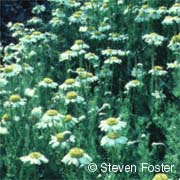Roman chamomile
Chamomile is one of the most popular herbs in the Western world. There are two plants known as chamomile: the more popular German chamomile (Matricaria recutita) and Roman, or English, chamomile (Chamaemelum nobile). Although they belong to different species, they are used to treat the same health problems. Both are used to calm frayed nerves, to treat stomach problems, to relieve muscle spasms, and to treat skin conditions and mild infections.
Many people drink chamomile tea. Chamomile can also be found in face creams, drinks, hair dyes, shampoos, and perfumes.
Most research on chamomile has been done with German chamomile. It has similar active ingredients, but they are not exactly the same.
Traditionally, Roman chamomile has been used to treat nausea, vomiting, heartburn, and gas. It is often used today to relieve anxiety. Used on the skin, it may also reduce inflammation from cuts or hemorrhoids. It is sometimes used to ease the discomfort from eczema and gingivitis (swollen gums).
Although chamomile is popular, there are not many studies about it. Test tube studies have shown that chamomile can kill bacteria, fungus, and viruses. It also helps relax muscle contractions, particularly in the smooth muscles that make up the intestines.
Plant Description
Roman chamomile comes from northwestern Europe and Northern Ireland where it creeps close to the ground and can reach up to one foot in height. Gray-green leaves grow from the stems, and the flowers have yellow centers surrounded by white petals, like miniature daisies. Its leaves are thicker than German chamomile, and it grows closer to the ground. The flowers smell like apples.
What is it Made Of?
Chamomile teas, ointments, and extracts all start with the white and yellow flower head. The flower heads may be dried and used in teas or capsules or crushed and steamed to produce a blue oil, which is used as medicine. The oil has ingredients that reduce swelling and may stop the growth of bacteria, viruses, and fungi.
Available Forms
Roman chamomile is available as dried flowers in bulk, tea, tinctures, and in creams and ointments.
How to Take It
Pediatric
Scientists have not studied Roman chamomile in children. Talk to your doctor to find the right dose before giving Roman chamomile to a child.
Adult
- Tea: Pour 1 cup of boiling water over 2 to 3 heaping tsp. (2 to 4 g) of dried herb, steep 10 to 15 minutes. Drink 3 to 4 times per day between meals.
- Bath: Use 1/4 lb. of dried flowers per bath, or add 5 to 10 drops of essential oil to a full tub of water to soothe hemorrhoids, cuts, eczema, perineal pain, or insect bites.
- Cream/Ointment: Apply cream or ointment containing 3 to 10% chamomile content.
Precautions
The use of herbs is a time-honored approach to strengthening the body and treating disease. Herbs, however, can interact with other herbs, supplements, or medications. For these reasons, you should take herbs with care, under the supervision of a health care provider.
Roman chamomile is considered generally safe.
Chamomile may make asthma worse, so people with asthma should not take it.
Pregnant women should avoid chamomile because of the risk of miscarriage.
If you are allergic to asters, daisies, chrysanthemums, or ragweed, you may also be allergic to chamomile.
Drinking a lot of highly concentrated chamomile tea may cause vomiting.
Chamomile may cause drowsiness, so DO NOT take it and drive.
Stop taking chamomile at least 2 weeks before surgery or dental work, because of the risk of bleeding.
Possible Interactions
If you currently take any of the following drugs, you should not use chamomile without first talking to your health care provider.
Blood thinning medications (anticoagulants and antiplatelets): Chamomile may increase the risk of bleeding when taken with blood-thinners such as warfarin (Coumadin), clopidogrel (Plavix), and aspirin.
Sedatives: Chamomile can make these drugs stronger, including:
- Anti-seizure drugs, such as phenytoin (Dilantin) and valproic acid (Depakote)
- Barbiturates
- Benzodiazepines, such as alprazolam (Xanax) and diazepam (Valium)
- Drugs to treat insomnia, such as zolpidem (Ambien), zaleplon (Sonata), eszopiclone (Lunesta), and ramelteon (Rozerem)
- Tricyclic antidepressants, such as amitriptyline (Elavil)
- Alcohol
The same is true of sedative herbs, such as valerian, kava, and catnip.
Blood pressure medications: Chamomile may lower blood pressure slightly. Taking it with drugs for high blood pressure could cause blood pressure to drop too low.
Diabetes medications: Chamomile may lower blood sugar. Taking it with diabetes drugs could raise the risk of hypoglycemia or low blood sugar.
Other drugs: Because chamomile is broken down by the liver, it may interact with other drugs that are broken down the same way. Those drugs may include:
- Fexofenadine (Seldane)
- Statins (drugs that lower cholesterol)
- Birth control pills
- Some antifungal drugs
Supporting Research
Briggs CJ, Briggs GL. Herbal products in depression therapy. CPJ/RPC. November 1998;40-44.
Heck AM, DeWitt BA, Lukes AL. Potential interactions between alternative therapies and warfarin. Am J Health Syst Pharm. 2000;57(13):1221-1227.
Hur MH, Han SH. Clinical trial of aromatherapy on postpartum mother's perineal healing. Taehan Kanho Hakhoe Chi. 2004;34(1):53-62.
Miller L. Herbal medicinals: selected clinical considerations focusing on known or potential drug-herb interactions. Arch Intern Med. 1998;158(20):2200-2211.
O'Hara M, Kiefer D, Farrell K, Kemper K. A review of 12 commonly used medicinal herbs. Arch Fam Med. 1998:7(6):523-536.
Rotblatt M, Ziment I. Evidence-Based Herbal Medicine. Philadelphia, PA: Hanley & Belfus, Inc. 2002:119-123.
Srivastava JK, Shankar E, Gupta S. Chamomile: A herbal medicine of the past with bright future. Mol Med Report. 2010 Nov 1;3(6):895-901.
Zhao J, Khan SI, Wang M, et al. Octulosonic acid derivatives from Roman chamomile (Chamaemelum nobile) with activities against inflammation and metabolic disorder. J Nat Prod. 2014;77(3):509-15.
Reviewed By
Steven D. Ehrlich, NMD, Solutions Acupuncture, a private practice specializing in complementary and alternative medicine, Phoenix, AZ. Review provided by VeriMed Healthcare Network.

 All rights reserved.
All rights reserved.